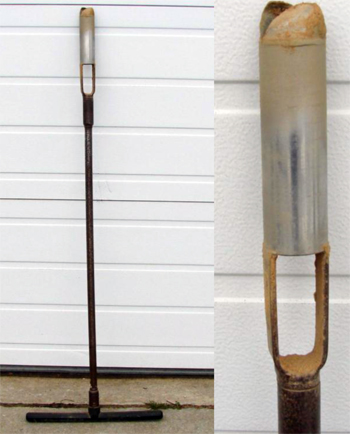Looking below the surface for effective soil management
Successful long term production of any crop starts with suitable soil followed by proper soil management. Production practices influence soil health and year-to-year profitability but to really appreciate and manage soil, look below the surface.
The majority of Michigan crops have their roots in the top 18 inches of soil. Many producers of annually planted crops focus their attention on an even smaller area of eight to ten inches since this is the depth they generally work the soil. However, they should also pay attention to greater depth - especially if they irrigate or plant in an area having a seasonally high water table. Deeper zones may not significantly contribute nutrients to plants but they do influence water drainage and potential leaching concerns for applied nutrients.
All soils transition through different soil types (horizons) at varying depths until they reach bedrock. Growers need to be aware of the soil type under top soil since many sites transition into much different soils than what is seen at the surface. Knowing this is especially important when it comes to water application and drainage. If the soil transitions to clay, water percolation will be slow and the site prone to standing water during wet periods – a condition few plants tolerate. These sites are not always in low-lying situations and if that is the case they will benefit from tile drainage.
Other sites may have heavier, finer textured soils (silt and clay) at the surface with a coarse-textured (sand) subsoil. In this case, water will move slowly through the surface layer but more quickly once below this layer. If the distance to sandier soil is not too far (less than 2 feet) plants on these sites will benefit from periodic (sometimes annual) sub soiling which provides channels for greater root penetration and quicker water drainage. Sub soiling is most beneficial when a compacted zone has been identified. The implement is operated slightly below the compacted layer when the soil is dry and care taken to avoid driving directly over loosened zones.
Other sites may have the desired sandy loam at the surface underlain with primarily sand. From a water drainage standpoint, this type of site is ideal for crop production but presents more water and nutrient management concerns than the other sites described. Once water moves beyond the surface layer in these situations, it will move quickly through the next layer, sometimes at 18 to 20-inches an hour. The danger on these sites is that irrigation will move nutrients beyond the root zone and potentially into the water table. This is not a good situation from an environmental standpoint but also is an economic waste of nutrients and water. It is important to understand that wherever water goes it carries nutrients. So water applications to these sites should be properly timed and measured to minimize movement beyond the root zone.
Determining deeper soil types is a fairly simple operation – just dig a hole. Bucket-type soil augers (Photo 1) are easier and can sample five or more feet and that is usually deep enough. Soil surveys are another possibility but they only provide a generalization of the soil types for the site. Soil survey books can be viewed at your local MSU Extension or Soil Conservation offices and are also available on line at http://websoilsurvey.nrcs.usda.gov/app/.

Photo 1. Left, bucket-type soil auger for deeper soil sampling. Right, two-inch in diameter bucket auger.
Doing a deep sample at various times during the season can determine seasonal position of the water table. This is especially helpful for sites having a fluctuating water table. This comes into play in the potential movement of nutrients into the ground water. If nutrients get flushed below the root zone during the growing season, it is possible they could move into ground water when the water table rises. Poorly drained sub soils are often gray in color due to iron ions existing in the reduced state. If the soil is moderately well to well drained, iron ions will have a chance to be oxidized, giving the soil a rusty or reddish appearance.
So when it comes to soil, don’t assume that, “What you see is what you get.” Look below the surface since knowing subsoil characteristics will greatly help in making water and nutrient management decisions.



 Print
Print Email
Email




